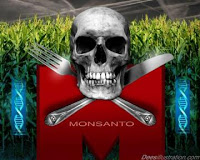 |
| Dees Illustration |
Brandon Turbeville
Activist Post
The approval of rBGH by the United States was yet another prime example of the revolving door between Monsanto, Big Pharma, and the FDA. In fact, the obvious conflict of interest among many of the FDA’s employees who were involved in the approval process actually prompted a GAO investigation in 1994.
One of the employees, Michael Taylor, began his career in 1976 with the FDA as an attorney. In 1981, he left the agency and took up a position with the law firm King & Spalding where one of his clients was Monsanto.[1]
This memo was part of what was essentially an internal discussion as to whether or not Monsanto could sue states or companies that wished to label their products as free of rBGH.[2] Later, the issue would arise in reality when many businesses decided to do just that.
In the end, Taylor was hired was hired by Monsanto through King and Spalding to draft a plan that he would later be integral in implementing as an employee of the FDA.
It is also noteworthy that as of July 2009, Taylor was appointed by the Obama administration to the position of senior advisor to the commissioner of the FDA. Riddled with ties to Monsanto, one of the major players in the approval of rBGH is now the American food safety czar.[3] One can read a much more detailed expose’ of Michael Taylor in my article, “Monsanto’s Leading Soldier in the War on Raw Milk.”
Indeed, Mr. Taylor’s treachery goes a bit further than just the approval of rBGH in the 1990s. Taylor was also instrumental in the devastating “Green Revolutions” in Asia and Latin America. He is also now involved in the development of the guidelines being used by the FDA for the purpose of enforcing the nightmarish Food Safety Modernization Act of 2010 (S. 510), one of the bills being used to SWAT team and terrorize Amish and organic farmers today.
Another major player in the rBGH game was Margaret Miller.
Miller was a former employee of Monsanto who, during the course of her employment, was responsible for coordinating animal safety studies regarding rBGH. In 1989 she left her job at Monsanto and went directly to the FDA where she was promoted to the position of director of the toxicology and environmental sciences division. This was the division that was directly responsible for the technical review of the safety of rBGH. [4]
Dr. Suzanne Sechen was also investigated by the GAO. As is documented by Lisa Nicole Mills in Science and Social Context: The Regulation of Recombinant Bovine Growth Hormone, both Sechen and Miller were openly compromised by their prior affiliations with Monsanto. Mills writes:
The GAO did, however, identify several articles authored or co-authored by Dr. Sechen and Dr. Miller, some of which had been written with the FDA listed as their address, ‘whose publication may have been contrary to FDA’s requirements for prior approval of outside activities.’ Articles written by Dr. Miller had been co-authored with Monsanto scientists; articles authored by Dr. Sechen had been co-authored with, among others, Professor Dale Bauman at Cornell University, who was principal investigator of clinical trials of Posilac conducted at Cornell.
At Cornell, Sechen’s faculty advisor was a consultant for Monsanto, and much of the research she conducted was a result of an agreement between Monsanto and her advisor.[6] Another example of welfare science, a condition that plagues academia and universities the world over, Sechen received her funding from a large corporation, which no doubt would have cut off the money had her conclusions not been to their satisfaction.
While at the FDA, Sechen was also responsible for evaluating some of the same articles she had published as a Monsanto-funded researcher at Cornell.[7]
Citizens will have to make connections between any links that person may have had to the corporation they are allegedly regulating at the moment and determine for themselves if these individuals are doing the job they have been tasked with by the public trust, or whether they are merely serving their corporate masters.
Unfortunately, the latter is almost always the case. Taylor, Miller, and Sechen are obviously not lone rangers when it comes to regulatory corruption.
[2] Smith, Jeffrey. “You’re Appointing Who? Please Obama, Say It’s Not So!” July 23, 2009. http://www.huffingtonpost.com/jeffrey-smith/youre-appointing-who-plea_b_243810.html Accessed May 24, 2010.
[3] Ibid.
[4] “rBGH:How Artificial Hormones Damage the Dairy Industry and And Endanger Public Health.” Foodandwaterwatch.org. June, 2009. http://www.foodandwaterwatch.org/tools-and-resources/rbgh-how-artificial-hormones-damage-the-dairy-industry-and-endanger-public-health/
[5] “Ibid.
[6] Ferrara, Jennifer. “Revolving Doors: Monsanto and the Regulators.” The Ecologist, Vol. 28, No. 5, September/October 1998.
[7] “rBGH:How Artificial Hormones Damage the Dairy Industry and And Endanger Public Health.” Foodandwaterwatch.org. June, 2009. http://www.foodandwaterwatch.org/tools-and-resources/rbgh-how-artificial-hormones-damage-the-dairy-industry-and-endanger-public-health/
Brandon Turbeville is an author out of Mullins, South Carolina. He has a Bachelor’s Degree from Francis Marion University where he earned the Pee Dee Electric Scholar’s Award as an undergraduate. He has had numerous articles published dealing with a wide variety of subjects including health, economics, and civil liberties. He also the author of Codex Alimentarius – The End of Health Freedom, 7 Real Conspiracies and Five Sense Solutions.
linkwithin_text=’Related Articles:’



Be the first to comment on "Case Study in Corporatocracy: Monsanto, Big Pharma, and the FDA Used Key Players to Approve rBGH"